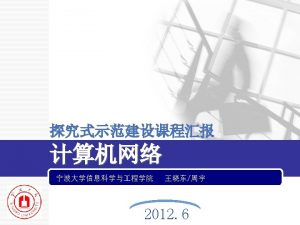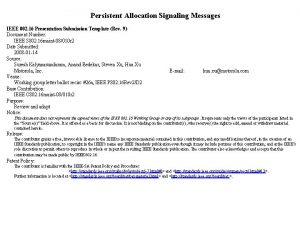MAP NACK Channel for Persistent Allocation IEEE 802



- Slides: 3

MAP NACK Channel for Persistent Allocation IEEE 802. 16 Presentation Submission Template (Rev. 9) Document Number: IEEE C 802. 16 maint-08/110 Date Submitted: 2008 -03 -10 Source: John Harris, Hua Xu Motorola, Inc. Venue: Working group letter ballot recirc #26 b, IEEE P 802. 16 Rev 2/D 3 Base Contribution: E-mail: hua. xu@motorola. com Purpose: Review and adapt Notice: This document does not represent the agreed views of the IEEE 802. 16 Working Group or any of its subgroups. It represents only the views of the participants listed in the “Source(s)” field above. It is offered as a basis for discussion. It is not binding on the contributor(s), who reserve(s) the right to add, amend or withdraw material contained herein. Release: The contributor grants a free, irrevocable license to the IEEE to incorporate material contained in this contribution, and any modifications thereof, in the creation of an IEEE Standards publication; to copyright in the IEEE’s name any IEEE Standards publication even though it may include portions of this contribution; and at the IEEE’s sole discretion to permit others to reproduce in whole or in part the resulting IEEE Standards publication. The contributor also acknowledges and accepts that this contribution may be made public by IEEE 802. 16. Patent Policy: The contributor is familiar with the IEEE-SA Patent Policy and Procedures: <http: //standards. ieee. org/guides/bylaws/sect 6 -7. html#6> and <http: //standards. ieee. org/guides/opman/sect 6. html#6. 3>. Further information is located at <http: //standards. ieee. org/board/pat-material. html> and <http: //standards. ieee. org/board/pat >.

MAP NACK for Persistent Allocation • A shared NACK region is designed for persistent MS to tell BS that a MAP decoding error occurred. • Due to the shared nature of this channel, – It is difficult for BS to tell which MS(s) is experiencing MAP decoding error – Whether the MAP decoding error will impact others – Does the BS need to re-send all or part of the MAP • The MAP channel is currently designed to be explicitly assigned in the initial persistent allocation IE, which is 6 bits per user persistent allocation IE • We propose: – CQI based NACK feedback channel allocation

CQI Based MAP NACK Channel Allocation • Group the users based on its CQI since the MS with bad CQI will be more likely to have MAP decoding error, therefore should be put into “fine” bucket. • The shared MAP NACK region consists of N channels, (5 channels, 0, 1, 2 3, 4, are used in the example for illustration purpose. ) – Channel 0 -3 are for users that have CQI < C (CQI threshold) • The MS will use a hash function of it user ID to determine its NACK channel, an example of a hash function could be the last two digits of its user ID – Channel 4 is for users that have CQI >= C • There is no need of NACK channel assignment to each individual users (overhead savings) • The user will select the corresponding NACK channel based on its latest CQI feedback value sent to BS and its user ID • BS is better informed on who are the users that just experienced MAP decoding error based on the latest CQI record it got from each user and their user ID • BS can make an educated decision on whether the MAP for frame K needs to be resent in frame K+4 • The C value shall be chosen based on – CQI distribution in the cell – System load – Persistent allocation scheme/algorithm • The information/settings about CQI threshold C and number of channels in NACK region N can be broadcasted in DCD/UCD





